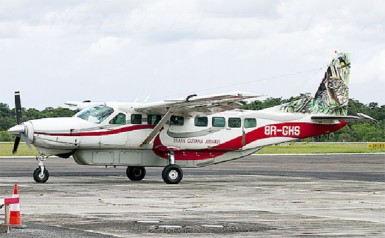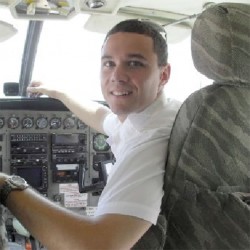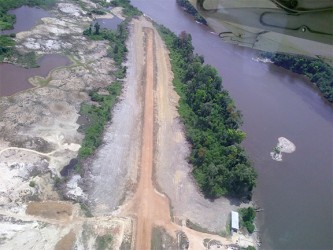A Trans Guyana Airways (TGA) plane is missing after going down shortly after take-off from the Olive Creek, Region Seven airstrip yesterday morning and a search and rescue operation is underway to find the Canadian pilot and Guyanese cargo handler who were on-board the aircraft.
Up to last evening, when the aerial search was suspended due to poor lighting, there was no sighting of the Cessna 208B Grand Caravan piloted by Canadian national Blake Slater with cargo handler Dwayne Jacobs on board.
Guyana Civil Aviation Authority (GCAA) Director Zulficar Mohammed said that the aerial search will resume today at 6:30 am in a location identified as an area of interest, located approximately 10 miles from the populated Olive Creek area. However, Mohammed said in a statement last evening that an aircraft was to be deployed to fly over the area last night to look for any signs of the missing plane. He noted that the US Mission Control Centre (USMCC), from which information concerning aircraft ELT signals is transmitted, has informed that it had not received any signal from the plane’s beacon.


The Olive Creek area in Region Seven is mountainous and covered with thick jungle. The Correia Group, TGA’s parent company, has a major mining operation there and oversees the airstrip.
TGA spokesman Kit Nascimento told Stabroek News that the missing plane, which bears registration number 8R-GHS, went down shortly after take-off from the small airstrip in the mountainous, jungle area. The plane was being used to shuttle mining supplies to Imbaimadai.
Nascimento said that at 10:55 am, shortly after the plane’s take-off from the airstrip, a distress call was received from the pilot.
He said that the airline immediately launched a full search and rescue operation using a plane that was in the area at the time. He said that TGA has a spot tracker satellite facility and has been able to locate where the aircraft is but it has not been spotted. “There is no visual sight of the aircraft at this point in time,” he said.
According to Nascimento, Slater is an experienced captain contracted to TGA and would have known the area well since TGA does not allow pilots to go to areas that they do not know well. “Yes, he would have known it well I suppose,” he said.
He added that as far as he knew, the weather was normal at the time of the take-off. He said that Slater is also an instrument-rated pilot so he could have flown on instruments.

Meanwhile, at a press conference yesterday afternoon, Mohammed reported that at around 10:56 am, two minutes after the plane’s take-off, Air Traffic Control received a message from another aircraft indicating that the TGA plane was going down while on a shuttle between Olive Creek and Imbaimadai. Other aircraft in the vicinity, he stated, commenced reconnaissance immediately over the area.
Mohammed said the GCAA Rescue Coordination Centre (RCC) was also immediately activated by the Air Traffic Control Centre and the Guyana Defence Force, the Police Force, the Minister of Public Works Robeson Benn, and GCAA and Cheddi Jagan International Airport (CJIA) staff reported to the RCC.
“Based on the last spot tracker information along with coordinates from the aircraft prior to going down, an area of interest was plotted and crews were briefed in the RCC,” Mohammed said, while adding that the area identified is in the remote, densely forested area in the vicinity of Olive Creek, mid Mazaruni.
However, Minister Benn said that the spot tracker cannot precisely pick up where the aircraft is, since it samples the area every ten minutes but might not necessary spot the aircraft. He added that the plane’s Emergency Locater Transmitter (ELT) could show the location of the plane but it was not triggered.
The aircraft is fitted with emergency equipment, including an Emergency Locator Beacon, 406Mhz.
“The ELT is only triggered upon heavy impact,” Benn explained. He added that the transmitter could be triggered manually by either the pilot or passenger. It was uncertain why the transmitter had not been triggered.
A Cessna Caravan from TGA, two helicopters from the GDF and Air Services Limited (ASL) were dispatched along with the GDF Special Forces to work on the ground.
The TGA Cessna Caravan was deployed around 1:10 pm yesterday with three crew members and eight Special Forces Officers along with equipment and survival kits, according to Mohammed. He added that the helicopters also departed around the same time. He also said that another aircraft from ASL joined the search mission. The rescue team includes two helicopters and four Cessna Caravans, nine Special Forces Officers and nine crew members.

The search was expected to continue until nightfall yesterday and Mohammed said he hoped they would receive something solid with all the resources they have put out. He also said that they were speaking with persons living in the areas close to where the aircraft is suspected to have gone down. He added that once solid information was received, ground searches will continue throughout the night.
Like Nascimento, Mohammed said that the pilot was an experienced flyer and would have had to meet standard requirements before he was allowed to fly in the interior.
Aircraft are also inspected on a daily basis by the approved maintenance organisation, which records its findings in the maintenance log book, Mohammed said. He added that if need be, aircraft are always serviced before pilots are allowed to fly them.




